The Future Of Home Home Heating - Exactly How Heat Pump Innovation Is Progressing
The Future Of Home Home Heating - Exactly How Heat Pump Innovation Is Progressing
Blog Article
Created By-Rosenthal Ringgaard
Heat pumps will be an important innovation for decarbonising heating. In Read Even more with governments' revealed energy and environment commitments, their international ability increases by 2030, while their share in home heating rises to one-quarter.
They work best in well-insulated homes and rely upon power, which can be supplied from a renewable power grid. Technical innovations are making them extra effective, smarter and more affordable.
Gas Cells
Heat pumps utilize a compressor, cooling agent, coils and fans to relocate the air and heat in homes and devices. They can be powered by solar power or electricity from the grid. They have been gaining popularity due to their affordable, peaceful operation and the ability to generate electrical energy throughout peak power need.
Some companies, like IdaTech and BG MicroGen, are servicing fuel cells for home heating. These microgenerators can change a gas central heating boiler and generate a few of a residence's electrical needs with a link to the electrical power grid for the rest.
Yet there are reasons to be unconvinced of using hydrogen for home heating, Rosenow claims. It would be pricey and ineffective compared to other innovations, and it would certainly contribute to carbon exhausts.
Smart and Connected Technologies
Smart home technology enables house owners to attach and control their tools from another location with using smart device applications. For instance, smart thermostats can learn your heating choices and immediately get used to maximize power intake. Smart lighting systems can be controlled with voice commands and automatically shut off lights when you leave the area, reducing power waste. And smart plugs can keep an eye on and manage your electrical usage, allowing you to recognize and restrict energy-hungry devices.
The tech-savvy family shown in Carina's meeting is a great image of exactly how passengers reconfigure area heating practices in the light of brand-new wise home modern technologies. They depend on the gadgets' automated functions to perform day-to-day changes and regard them as a hassle-free ways of conducting their heating methods. Because of this, they see no factor to adjust their techniques even more in order to make it possible for adaptability in their home power demand, and treatments targeting at doing so may encounter resistance from these families.
Power
Considering that heating up homes make up 13% of US emissions, a button to cleaner choices can make a huge distinction. However the innovation faces challenges: It's pricey and needs considerable home improvements. And it's not always compatible with renewable energy sources, such as solar and wind.
Up until just recently, electric heatpump were as well pricey to compete with gas versions in most markets. However new technologies in layout and materials are making them a lot more budget friendly. And much better chilly climate efficiency is allowing them to work well even in subzero temperature levels.
The following action in decarbonising home heating might be making use of heat networks, which draw warmth from a main source, such as a nearby river or sea inlet, and disperse it to a network of homes or structures. That would lower carbon emissions and permit families to benefit from renewable resource, such as eco-friendly electricity from a grid provided by renewables. This option would be less expensive than changing to hydrogen, a nonrenewable fuel source that requires brand-new facilities and would just decrease carbon dioxide emissions by 5 percent if paired with improved home insulation.
Renewable resource
As electrical power rates drop, we're beginning to see the exact same fad in home heating that has driven electrical autos right into the mainstream-- but at an also faster speed. The solid environment instance for impressive homes has actually been pushed additionally by new research.
Renewables make up a significant share of contemporary heat consumption, yet have been given limited plan focus globally contrasted to various other end-use industries-- and also less interest than electricity has. In part, this shows a mix of consumer inertia, split rewards and, in lots of nations, aids for nonrenewable fuel sources.
New innovations could make the change easier. For example, heatpump can be made more energy efficient by changing old R-22 refrigerants with new ones that do not have the high GWPs of their precursors. Some specialists likewise picture area systems that draw warmth from a close-by river or sea inlet, like a Norwegian fjord. The warm water can after that be made use of for heating & cooling in a community.